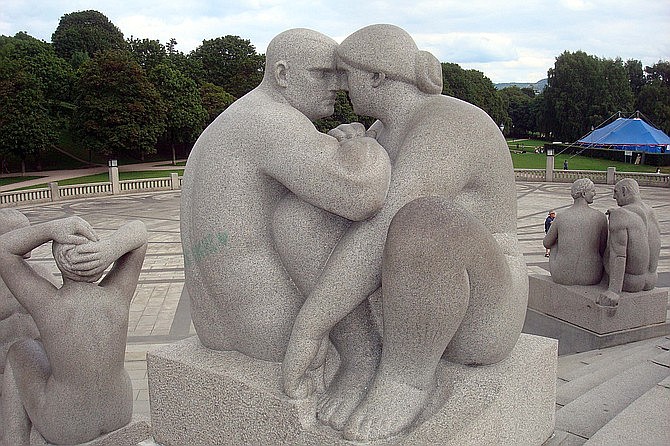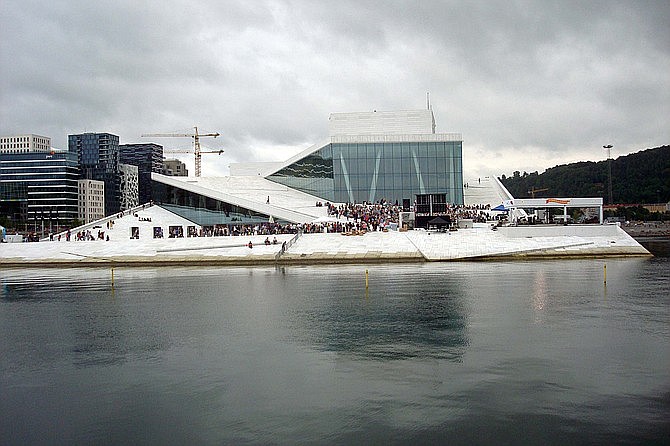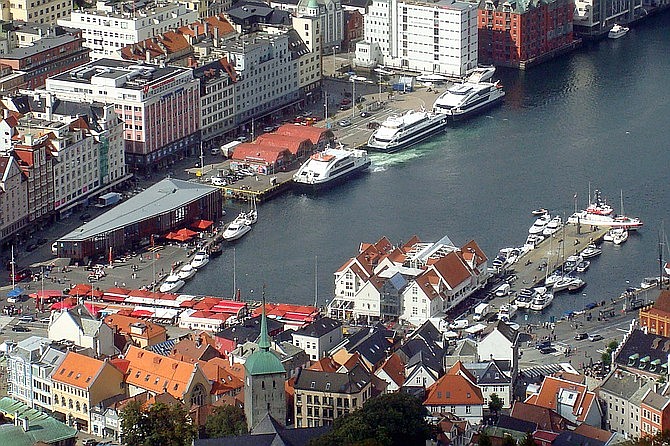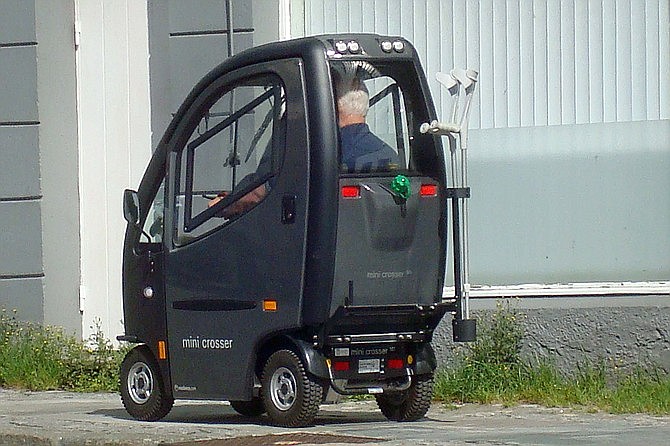 Facebook
Facebook
 X
X
 Instagram
Instagram
 TikTok
TikTok
 Youtube
Youtube

I’ll be honest. We visited 131 countries before finally summoning the courage to travel to Norway. No, we weren’t worried about crime, political instability, or unhealthy conditions. In fact, there's almost a complete absence of anything annoying there.
Rather, we were frightened by accounts of how almost obscenely expensive the country is. But there are also a number of free and low-cost activities. Here's some guidance on things to do that will make your kroners go further.
We spent our first week in Oslo. One of the free highlights is the Vigeland Sculpture Park, which is host to the world’s largest collection of statues created by a single artist. Gustav Vigeland was in the right place at the right time when in 1905 Norway gained its independence from Sweden.

Being one of the few European-trained sculptors in a fiercely nationalistic country, he was immediately commissioned to produce a number of busts and statues commemorating famous Norwegians. Soon thereafter, he arranged with the city to provide a home and workshop in exchange for agreeing to donate all of his works, drawings, engravings and models. There he worked almost obsessively, producing sculptures representing people of all ages in all stages of life and everyday situations: children taking their first steps, teenagers first experience sexual attraction, old people taking their last steps, and probably the most photographed of all, a two year old who has just had his candy taken back.
These quintessential themes of life and relationships are more striking because all of the poses are in the nude, thereby eliminating any distinctions of class or time.

Another free highlight of Oslo is the Opera House, completed in 2008, with angled surfaces looking either like tectonic plates rising from the water, or perhaps a water lily emerging into a flower from beneath the surface. Who would have thought of building a public plaza on top of a 1400 seat acoustically-perfect hall? But the populace of Oslo has embraced walking over its white marble-covered roof, and is even permitted to skateboard on parts of it. Such a pleasant place to pass an afternoon, often to the accompaniment of local groups playing a wide variety of music.
We spent another full week on the west coast of Norway in Bergen. Once the center of a huge German trading empire called the Hanseatic League, Bergen is now Norway’s second largest city with a diminutive population of just 275,000, but feeling much larger as hordes of tourists disgorge from the cruise ships that visit the town daily.
The entire city has been declared a UNESCO World Heritage site, and extensive archaeological excavations – once again thanks to all the oil money with which Norway has been blessed – make the medieval town come alive for the modern visitor.

Wandering the streets of timber-clad houses tucked into every square inch around a scenic harbor – with cobblestone streets rich in quality artisan shops and pleasant cafes – was our main activity of the week. But another must-do in Bergen is the funicular up Mt. Floyen. In addition to a spectacular panorama of all of Bergen, the top of the mountain is the starting point for a number of well-marked trails to explore. In fact, if you are carefully counting your kroners, you may wish to take the forty-minute walk down, rather than ride the funicular.
But the best reason to go to Norway is not to visit the two cities positioned on each side of the country, but rather to experience the fabulous scenery that lies between them. Norway is draped with dramatic landscapes ranging from the highest altitude stop of any train line in Europe, steep walled fjords, quaint villages and many magnificent waterfalls.
A sampling of all of these wonders can be had by signing-up for the Norway-in-a-Nutshell itinerary which links together public trains, ferries and buses for a glimpse of each of these marvelous backdrops. Although you can do this by just asking for the Norway-in-a-Nutshell package at any travel agency or tourist information office, considerable savings can be had by buying tickets for each leg separately and doing so in advance to get the “mini-prix” special rates. This saved us about fifty percent of the rates quoted by going the commercial route.

So, forget what you have heard as Norway being a country to put off visiting until you have won the lottery. It offers wonderful art, culture, a laboratory of social activism, people with an extreme sense of national pride, and best of all some of the most breathtaking scenery in the world.
You'll be inspired by this country that simply has its act together. If somehow one could skip the need for sleeping and eating, it would be the perfect destination!


I’ll be honest. We visited 131 countries before finally summoning the courage to travel to Norway. No, we weren’t worried about crime, political instability, or unhealthy conditions. In fact, there's almost a complete absence of anything annoying there.
Rather, we were frightened by accounts of how almost obscenely expensive the country is. But there are also a number of free and low-cost activities. Here's some guidance on things to do that will make your kroners go further.
We spent our first week in Oslo. One of the free highlights is the Vigeland Sculpture Park, which is host to the world’s largest collection of statues created by a single artist. Gustav Vigeland was in the right place at the right time when in 1905 Norway gained its independence from Sweden.

Being one of the few European-trained sculptors in a fiercely nationalistic country, he was immediately commissioned to produce a number of busts and statues commemorating famous Norwegians. Soon thereafter, he arranged with the city to provide a home and workshop in exchange for agreeing to donate all of his works, drawings, engravings and models. There he worked almost obsessively, producing sculptures representing people of all ages in all stages of life and everyday situations: children taking their first steps, teenagers first experience sexual attraction, old people taking their last steps, and probably the most photographed of all, a two year old who has just had his candy taken back.
These quintessential themes of life and relationships are more striking because all of the poses are in the nude, thereby eliminating any distinctions of class or time.

Another free highlight of Oslo is the Opera House, completed in 2008, with angled surfaces looking either like tectonic plates rising from the water, or perhaps a water lily emerging into a flower from beneath the surface. Who would have thought of building a public plaza on top of a 1400 seat acoustically-perfect hall? But the populace of Oslo has embraced walking over its white marble-covered roof, and is even permitted to skateboard on parts of it. Such a pleasant place to pass an afternoon, often to the accompaniment of local groups playing a wide variety of music.
We spent another full week on the west coast of Norway in Bergen. Once the center of a huge German trading empire called the Hanseatic League, Bergen is now Norway’s second largest city with a diminutive population of just 275,000, but feeling much larger as hordes of tourists disgorge from the cruise ships that visit the town daily.
The entire city has been declared a UNESCO World Heritage site, and extensive archaeological excavations – once again thanks to all the oil money with which Norway has been blessed – make the medieval town come alive for the modern visitor.

Wandering the streets of timber-clad houses tucked into every square inch around a scenic harbor – with cobblestone streets rich in quality artisan shops and pleasant cafes – was our main activity of the week. But another must-do in Bergen is the funicular up Mt. Floyen. In addition to a spectacular panorama of all of Bergen, the top of the mountain is the starting point for a number of well-marked trails to explore. In fact, if you are carefully counting your kroners, you may wish to take the forty-minute walk down, rather than ride the funicular.
But the best reason to go to Norway is not to visit the two cities positioned on each side of the country, but rather to experience the fabulous scenery that lies between them. Norway is draped with dramatic landscapes ranging from the highest altitude stop of any train line in Europe, steep walled fjords, quaint villages and many magnificent waterfalls.
A sampling of all of these wonders can be had by signing-up for the Norway-in-a-Nutshell itinerary which links together public trains, ferries and buses for a glimpse of each of these marvelous backdrops. Although you can do this by just asking for the Norway-in-a-Nutshell package at any travel agency or tourist information office, considerable savings can be had by buying tickets for each leg separately and doing so in advance to get the “mini-prix” special rates. This saved us about fifty percent of the rates quoted by going the commercial route.

So, forget what you have heard as Norway being a country to put off visiting until you have won the lottery. It offers wonderful art, culture, a laboratory of social activism, people with an extreme sense of national pride, and best of all some of the most breathtaking scenery in the world.
You'll be inspired by this country that simply has its act together. If somehow one could skip the need for sleeping and eating, it would be the perfect destination!
Comments